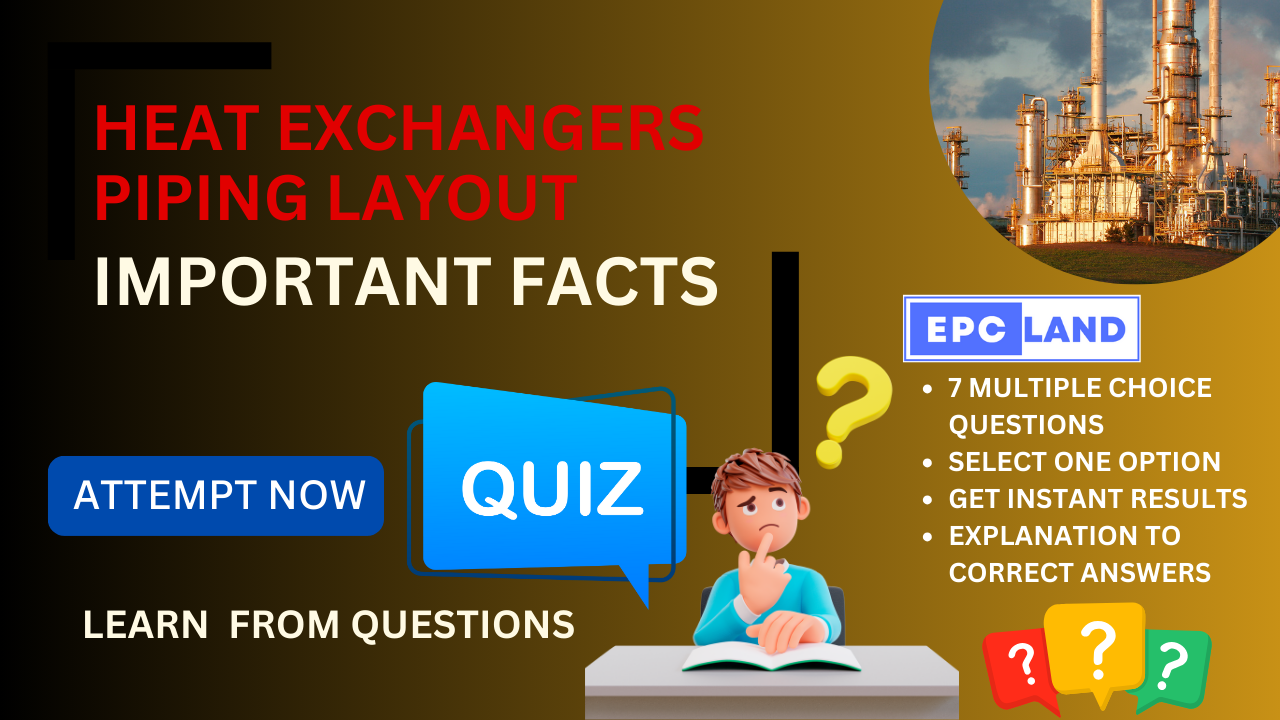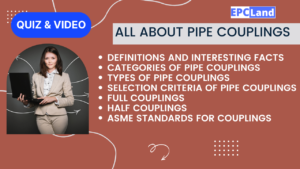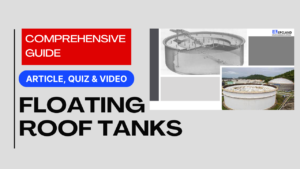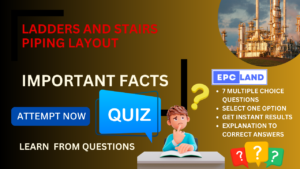1. Heat Exchangers Piping Layout
How should piping be arranged for tubular heat exchangers with removable tube bundles while developing Heat Exchangers Piping Layout?
Explanation: Piping for tubular heat exchangers with removable tube bundles shall not interfere with the free removal of the bundle.
2. Inlet and Outlet Valves in Water Lines
According to Exchangers Piping and Layout, what should be provided in water lines to and from tubular units?
Explanation: Inlet and outlet valves should be provided in water lines to and from tubular units according to Exchangers Piping and Layout.
3. Vents in Outlet Piping
What size of valved vents should be provided in outlet piping from liquid-cooled exchangers at the high point?
Explanation: Provide 3/4 inch valved vents in outlet piping from liquid-cooled exchangers at the high point.
4. Drain Valves for Salt Water Cooled Exchangers
What is the purpose of providing drain valves for salt water cooled exchangers?
Explanation: Drain valves for salt water cooled exchangers are provided to permit complete draining of the exchanger piping downstream of block valves.
5. Exchanger Piping and Handling Facilities
According to Exchangers Piping and Layout, where should exchanger piping not run in the way?
Explanation: Exchanger piping shall not run in the way of built-in or mobile handling facilities according to Exchangers Piping and Layout.
6. Wrench Clearance at Exchanger Flanges
What is the purpose of providing wrench clearance at exchanger flanges?
Explanation: Wrench clearance shall be provided at exchanger flanges for ease of maintenance.
7. Removal of Shell End and Channel Cover
How should piping be arranged to not hinder the removal of shell end and channel cover and withdrawal of the tube bundle?
Explanation: Pipes should be arranged so that they do not hinder the removal of shell end and channel cover and withdrawal of the tube bundle. Break up flanges should be provided wherever required.
8. Floating Head Exchangers and Tube Bundle Removal
For floating head exchangers, what must be allowed at the channel end?
Explanation: For floating head exchangers, a tube pulling or rod cleaning area must be allowed at the channel end.
9. Platform for Vertical Exchangers
What should be provided below the top flange of the channel/bonnet for vertical exchangers?
Explanation: A suitable platform should be provided below the top flange of the channel/bonnet for vertical exchangers.
10. Minimum Clearance Between Horizontal Exchangers
What is the minimum clearance between two horizontal exchangers?
Explanation: The minimum clearance between two horizontal exchangers should be 2m or 900mm aisle, whichever is higher.
11. Monorail for Tube Bundle Removal
For which exchangers is a monorail to be provided for tube bundle removal, according to Exchangers Piping and Layout?
Explanation: A monorail is to be provided for tube bundle removal for all exchangers except those that are open to the sky.
Table of Contents
Don’t miss the Course on Effective Isometrics Management: Check Now
Enrollment Link
Recommended courses (Published on EPCLand)
- Complete Course on Piping Engineering
- Basics of Piping Engineering
- Piping Layout Engineering
- Piping Material Engineering
- Piping Stress Analysis
- Material Requisitions
- Piping Material Specifications
- Valve Material Specifications
- Plant Design & Layouts-OISD 118
- Isometric Management
Library of Technical Articles
Don’t miss out the collection of 15+ articles on following topics:
- Basics of Oil and Gas Industry
- Valves
- Testing
- Tank
- Piping Bulk Items
- Pipe
- Metallurgy
- Piping Materials
- Layout
- Instrumentation
- Heat Exchanger
- Type of Contracts
- Codes and Standards
- ASTM Standards
- Articles on Piping Specialty Items
Video details of Complete Course on Piping Engineering
Why Enroll in the EPCLand
Proven Track Record– PTR
Activities & Achievements before launching EPCLand
- Published more than 50+ short courses
- 3000+ Enrolments
- More than 3,500,00 Minutes of watch hours in the last 2 years
- 4000+ Students in 100+ Countries
- Rating of 4+ out of 5
- 1000+ YouTube Videos
- 8K+ Subscribers
What Students will Learn
- Codes & Standards of the Energy Sector
- Piping Material Engineering
- Piping Layout Engineering
- Stress Analysis
Interesting facts
- All the published courses have been developed by Industry Experts with more than 2 decades of experience
- Content is based on Practical experience and real-time problems.
- Content is designed and organized in such a manner that it can be easily grabbed.
- Complete website, Blogs and Quiz sections are Planned, Designed and published by myself (About me: Atul Singla)
- Complete flexibility of Time & Location, Students can access the content from anywhere & anytime
- Moreover, once enrolled, the content can be access as many times as you want, which helps in understand the fundamentals in a better way.
Conclusion
In conclusion, our courses are meticulously crafted by industry experts with over two decades of hands-on experience. The content is rooted in practical knowledge, addressing real-time problems. The material is thoughtfully designed and organized for easy comprehension. Every aspect, from the website to blogs and quizzes, has been planned, designed, and executed by Atul Singla, ensuring a comprehensive and seamless learning experience. With the flexibility of accessing the content at any time and from any location, students have the freedom to learn on their terms. Furthermore, enrollment grants unlimited access, allowing learners to revisit the material as often as needed, fostering a deep understanding of the fundamentals.



